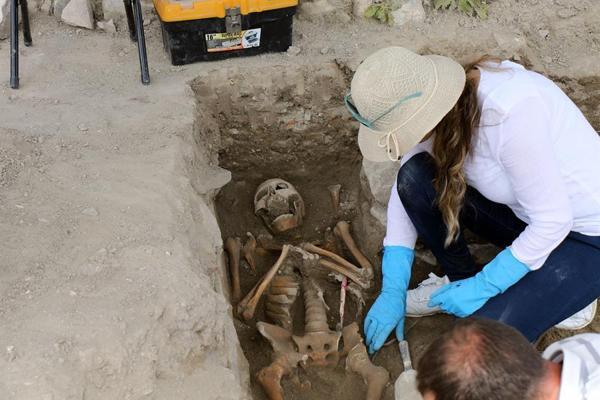Human skeletons found in Kuşadası excavations
AYDIN


In this year’s excavations at the historical Kadı Castle ruins in the western province of Aydın’s Kuşadası district, the skeletons of five people, two of whom were children, have been found. The skeletons are believed to be from the 13th century.
Kadı Castle, which is eight kilometers from the district center and whose history goes back to 5,000 years ago, was known as “Anaia” in the ancient age.
In the castle, which attracts attention with its mosque and church structure located side by side, five human skeletons, two of which belong to children, were unearthed during the excavations this year.
Speaking to the state-run Anadolu Agency, the Aydın Archaeology Museum Director Abdulbari Yıldız said that the Kadı Castle, which was built on a mound, had an uninterrupted life until the 14th century A.D., and that the castle was used for military purposes in the Republic period.
Stating that excavations have been continuing around the church of the ruins, Yıldız said, “Based on the posture and burial style of the skeletons found in five tombs, we determined that they were people of the Christian religion.”
“Anthropological work on the tombs continues. We think that there were many burials here, after the abandonment of the church in the 13th century. Since life did not exist here from the 14th to the 20th century, the graves are intact. All of the skeletons we found this year have are intact, too.”
Yıldız stated that they did not determine trauma or similar death in the skeletons they examined, adding, “Only one child has a skull fracture. I think this fracture was caused by fall. Since the church is a sacred place, people wanted to bury their graves close to the church. Actually, this is not a cemetery, but people with high religious qualifications were buried here.”
Yıldız added that necklaces and bracelets with cross motifs were also found in the tombs.
Scientific studies in the Kadı Castle, one of the important parts of Kuşadası’s cultural heritage, have been carried out under the leadership of Ege University Art History Department academic Professor Zeynep Mercangöz.
The excavations at the castle, prehistoric-era terracotta pots, disc crushers, stone axes as well as statues from the Hittite period, glazed ceramics from the 12th and 13th centuries A.D., jewelry, saint’s icon, eight-century-old tile fragments with seal prints and animal footprints have been found.
The finds are exhibited at the Aydın Archeology Museum.
